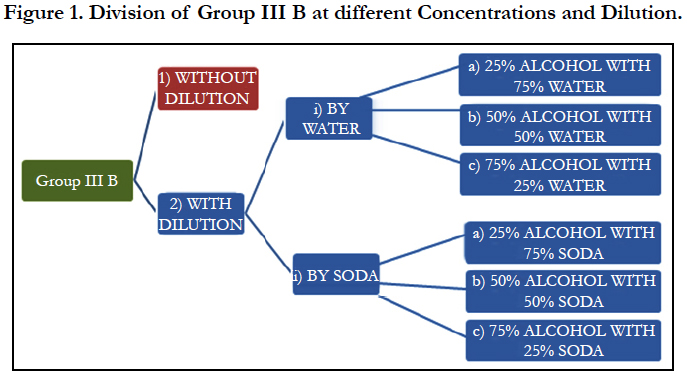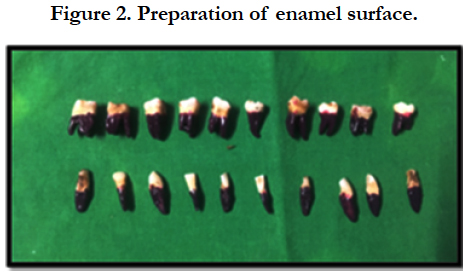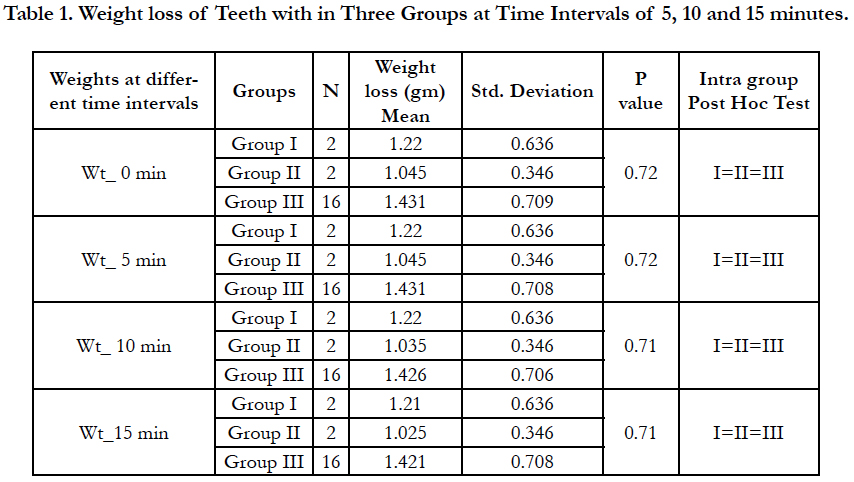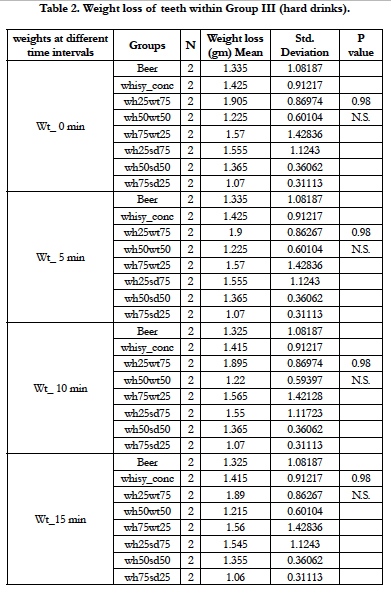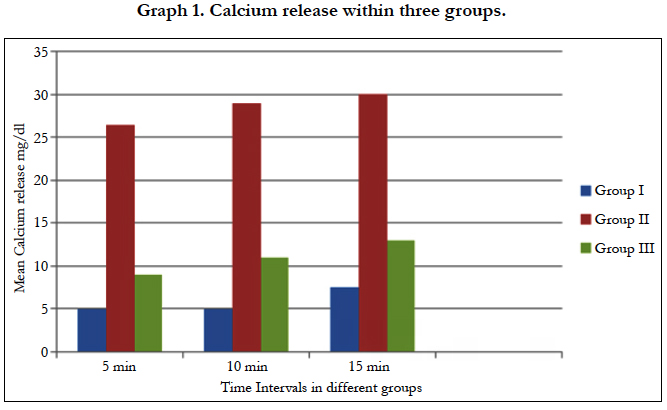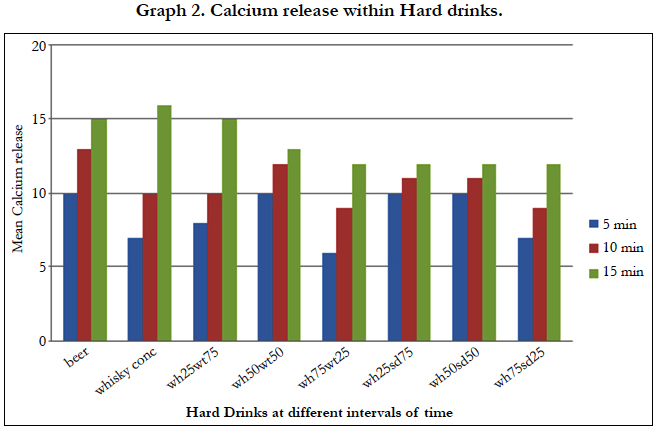Evaluation of Enamel Solubility on Exposure to Hard Drinks: An In-Vitro Study
Charpe MP1*, Dhole A2, Motwani M2
1 Post graduate student, Department of Oral medicine & Radiology, VSPM Dental College, Nagpur, India.
2 Professor, Department of Oral medicine & Radiology, VSPM Dental College, Nagpur, India.
*Corresponding Author
Dr. Manjiri P. Charpe,
Post Graduate Student, Department of Oral medicine & Radiology, VSPM Dental College, Nagpur, India.
Tel: 08237791226
E-mail: manjiric10@gmail.com
Received: December 24, 2018; Accepted: November 25, 2019; Published: November 26, 2019
Citation:Charpe MP, Dhole A, Motwani M. Evaluation of Enamel Solubility on Exposure to Hard Drinks: An In-Vitro Study. Int J Dentistry Oral Sci. 2019;6(5):697-702. doi: dx.doi.org/10.19070/2377-8075-19000137
Copyright: Charpe MP©2019. This is an open-access article distributed under the terms of the Creative Commons Attribution License, which permits unrestricted use, distribution and reproduction in any medium, provided the original author and source are credited.
Abstract
Introduction: Frequent and prolonged exposure to low pH may result in a more rapid demineralization of the enamel surface. When compared to soft drinks, a person tends to consume the same quantity of hard drinks for longer duration at each episode. Even though exposure of drinks to oral cavity may remain for 2-3 minutes but it causes drop in pH which takes longer time to resume back to normal levels.
Aims and Objectives: To evaluate and compare enamel solubility of teeth on exposure to hard drinks over different intervals of time.
Materials and Method: Enamel solubility will be checked in 3 different beverages like soft drink, hard drinks and water (control) for different intervals of time. Two types of hard drinks (Beer & Whisky) will be included in the study. Extracted, Non-carious permanent incisors and molars 15 each will be selected. The amount of loss of calcium will be determined by the weight loss of the tooth. The calcium that will be released into the beverages will be determined by using Calcium Reagent Set and measured using Semi Automatic Analyser.
Results: Mean calcium loss is found to be significant in soft drink. While, in hard drinks, it is more in beer and concentrated whisky.
2.Introduction
3.Aim & Objectives
4.Materials and Method
4.1 Selection of beverages and pH measurement
4.2 Selection and Cleaning of teeth
4.3 Preparation of enamel surface
4.4 Determination of weight loss of tooth
4.5 Determination of calcium
5.Results
6.Discussion
7.Clinical Significance
8.Conclusion
9.References
Keywords
Enamel Solubility; Dental Erosion; Calcium Loss; Weight Loss.
Introduction
An enamel is the hardest tissue and forms the outermost layer of teeth. So, it is the one to get exposed to the altered environment in the oral cavity due to various food items, beverages and even addictive substances. These all will cause irreparable damage to enamel leading to its dissolution and destruction. Dental erosion involves the chemical removal of minerals from tooth surface, initially from enamel surface followed by dentin. It causes severe sensitivity and makes tooth prone for dentinal caries and further destruction. It is caused by sustained direct contact between tooth surfaces and acidic substances. Acids in the mouth originate from three main sources like in situ production by acidogenic bacteria, ingested extrinsic acids as dietary components and dislocated intrinsic acids through the backflow of gastric contents [1]. Human saliva contains bicarbonates and urea, and due to their buffering action rapidly neutralizes the acidic remnants and returns the oral pH to normal. So, they play an important role in pH regulation. But as the content of acids in the beverages is high that of the critical level (pH < 5.5) and increased frequency of its intake, leads to dissolution of more number of mineral ions.
Now-a-days, under the name of freedom and civilization majority of population specially adolescents are getting attracted towards frequent soft drinks and hard drinks consumption. Out of these drinks, soft drinks and fruit juices have been extensively investigated over a long period for causing acid dissolution and erosion of dental enamel. Various previous studies have shown the erosive potential of soft drinks on dental tissues. Among the published literature, coca cola has pH below 5.5 and dissolve enamel, compared to other energy drinks [2-5, 7]. Chronic consumption of such type of beverages affect the systemic health of individuals causing chronic diseases such as hypertension, diabetes and obesity. It also leads to increased prevalence of dental caries and dental erosion. Smith BG et al., Boteva E, Manarte P et al., found dental erosion in chronic alcoholics. So, alcohol may be considered as one of the factor for dental erosion. In comparison to soft drinks, hard drinks have more addiction potential which induces its frequent consumption. It is frequently consumed either in concentrated form or in dilution with soft drinks, soda or water. Due to the synergistic effect of these combinations, it poses a major issue for the more demineralization of enamel. This dropped pH may attribute to increased prevalence of dental erosion.
India’s alcohol market is among the world’s fastest growing. Worldwide, 44.8% of total recorded alcohol is consumed in the form of spirits. The second most consumed type of beverage is beer (34.3%) followed by wine (11.7%).
Beer is one of the oldest alcoholic drink in the world. It is formed by complex fermentation process of starch products, mainly malted barley, wheat, rice and maize. Increasing income, urbanization, growing youth population as well as rising acceptance of social drinking have buoyed the growth of beer market in India. Similarly, whisky is a type of distilled alcoholic beverage made from fermented grain mash, including barley, corn, rye and wheat. According to, a leading source of data and analysis on the alcohol beverage market, in 2017- 2021 forecast by International Wine and Spirits Research (IWSR) Whisky consumption in India has more than doubled, from 80.2 million nine-litre cases in 2007 to 193.1 million nine-litre cases in 2016. It indicates that Indians have a preference for whisky, consuming half of the world’s production [9]. The country is also the world’s largest producer of whisky. So, we incorporated use of these beverages to evaluate their effects on enamel.
Enamel solubility can be evaluated by assessing calcium release or enamel hardness or by measuring weight loss of teeth. Few studies have been conducted in the past to evaluate enamel solubility potential of different beverages by following the methodology of evaluating the weight loss as a measure of enamel solubility.
So, the present study was planned to evaluate enamel solubility and calcium loss mainly by the effects of hard drinks on teeth in association with various commercial beverages.
Aim & Objectives
The present study was aimed to evaluate enamel solubility of teeth on exposure to hard drinks. While, the objectives were to evaluate enamel solubility on exposure to different concentrations of alcohol over different intervals of time and to compare it with other groups of beverages.
Materials and Method
After getting an approval from Institutional Ethical Committee, this observational study was carried out under following stages.
The beverages included in the study were divided into 3 major groups as:
Group I - Water (Control),
Group II -Soft drink ( Cola) and
Group III - Hard drinks. (A- Beer and B- whisky)
pH of the selected beverages of all the groups was measured by using digital pH meter.
In the present study, coca cola was used as representative sample of soft drink. Hard drinks were divided according to amount of alcohol content i.e. Group III A - Beer (4-6% alcohol) and Group III B- Whisky (40-60% alcohol). Each tooth was immersed in an individual beverage for time interval of 5, 10 and 15 minutes represented as T1, T2 and T3 subgroups respectively.
Hard drinks are consumed either in concentrated form or diluted with water or soda. Having less alcohol content, beer is preferably consumed in concentrated form while whisky is consumed either in diluted form or in concentrated form. So, Group III- B (whisky) was diluted as per the dilution with different proportions of water and soda. Figure 1 shows the diagrammatic representation of division of Group III-B at different concentrations and dilution.
Extracted, non-carious permanent incisors and molars (10 each) were selected. These selected teeth were first cleaned properly with hydrogen peroxide for 10 seconds and then with water to remove stains.
Three coats of nail varnish was applied to the whole surface area of root i.e. from cemento-enamel junction to apex, exposing only the surface of enamel so as to prevent any release of calcium from the cementum.(Figure 2)
Total 20 teeth were analyzed for the amount of loss of calcium and this was determined by the weight loss of teeth. The weight of tooth was measured by digital microbalance prior and after the immersion into respective beverage groups at each time interval of 5 min, 10 min & 15 min.
The calcium released into the beverages was determined by using Calcium Reagent Set (Accucare, Labcare Diagnostic Pvt. Ltd) using Semi Automatic Analyser. In this, 10 ml of respective beverage was taken in a separate clean collecting tube for each tooth individually. The beverages were then tested for calcium content after immersion of the teeth at intervals of 5 min, 10 min and 15 min. Based on time intervals and concentration, total 60 samples were analysed for calcium loss.
Results
Statistical analysis was performed using SPSS software, version 20.0. For assessment of both weight loss and calcium release, Repeated measures ANOVA test was performed for inter-group correlation. While, one way ANOVA with Post- Hoc Tukey’s test was performed for intra- group correlation.
The pH of water, cola, beer and whisky were measured as 6.33, 2.45, 4.01 and 4.34 respectively, which showed that all the beverages were below critical pH except water.
When all these beverages were evaluated for weight loss of teeth prior and after immersion, mean weight loss is found to be statistically non significant at time intervals of 5, 10 and 15 minutes (Table 1).
When hard drinks were evaluated in both concentrated and diluted forms, mean weight loss at different concentrations and dilution over different intervals of time, was found to be statistically non significant (Table 2).
Calcium release measured at time intervals of 5, 10 and 15 minutes was increased in group II and III. It was found to be significant in group II (p <0.001).(Graph 1)
When mean calcium release within hard drinks were evaluated, it was found to be increased with time for every group. After 5 minutes, calcium release was same for beer, diluted whisky with water at 50 % (whisky 50%+ water 50%) and diluted whisky with soda at 25% and 50%. But, after 10 minutes, it was highest in beer. The mean calcium release was found increased in Beer for time interval of 5 and 10 minutes as compared to both concentrated and diluted forms of whisky. Whereas it was found to be more in concentrated whisky after 15 minutes as compared to beer and its diluted forms with water and soda. (Graph 2).
Discussion
Assuming to be innocent, acid foods are consumed very widely throughout the world. Along with fruit juices and other beverages, there is increased tendency for consumption of hard drinks, especially among children and youth. Previous studies have tried to evaluate enamel solubility on exposure to soft drinks and such beverages. So, the current study was intended to evaluate the enamel solubility potential of hard drinks. Though acute consumption of soft drinks will have negligible effect on teeth enamel, it is well recognized that repeated consumption of soft drinks causes acid dissolution of enamel as most of these commercially available drinks have pH below the critical level.
The acidity of beverages is considered to be the primary factor in the development of dental erosion which leads to increased sensitivity and tooth wear. In the current study we found acidic nature of hard drinks similar to the results obtained by Zanatta et al., and Borjian A. Fraunhoner (2004), Dhanekar K et al., (2013), Owens et al., (2014), Tadakmadla J et al., (2014), Zimmer S et al., (2015), Panda A et al., ( 2017) found that enamel solubility was significant in cola drinks in comparison to other fruit juices, energy drinks, tea and other non cola beverages which was in accordance with the results obtained in our study.
An association between the ingestion of acidic drinks and dental erosion has been recognized by prior studies [1, 3-5, 7]. Worldwide percentage of population consuming alcohol has increased. Smith et al., Boteva E, Manarte P et al., found dental erosion in chronic alcoholics [10]. Zanatta et al., evaluated harmful effects of only beer on enamel microhardness [11]. So, the present study was planned to assess the enamel solubility of teeth especially by the two commonly consumed hard drinks (beer & whisky) and its comparison with soft drinks at different intervals of time.
The methodology of evaluating the weight loss as a proxy measure of enamel solubility methodology has been used in many of the previous studies which gives relative indication of the solubility potential of the beverages. So, in the present study, enamel solubility was assessed by mean weight loss and evaluation of calcium release in the beverages. The calcium ions released from enamel surface are measured by various methods like mean weight loss, enamel microhardness, and using advanced techniques like spectrophotometry, semi and fully automatic analyzer. In the study, we have assessed calcium release using Calcium reagent kit and measured by semi automatic analyzer.
Usually, in comparison to soft drinks, people consume hard drinks sip by sip which takes longer duration to finish it, causing more exposure to decreased pH. As the acidic environment in oral cavity lasts for at least 25 minutes after exposure to beverages , decrease in pH will last longer in case of hard drinks [4]. In the present study, the mean weight loss of teeth was found to be statistically non significant in all the groups (water, soft drink & hard drink) for time intervals of 5 min, 10 min and 15 min, which is not in accordance with the prior studies which have shown significant mean weight loss but for period of more than 24 hours.
We found that enamel solubility was more in cola as compared to other groups, which is in accordance to previous studies [4-7, 9]. Similarly, significant increase in calcium release was seen in soft drinks as compared to hard drinks, which is in accordance to results obtained by Zanatta et al., (2016) who had evaluated the same only for beer.
Acute consumption of these beverages have negligible effect on weight loss of teeth. While, mean calcium release is evident even at the shorter duration of time with the advent of advanced semi automatic analyzer. So, it is proving it to be more sensitive method for evaluating enamel solubility. In comparison to previous studies, it was the first study which evaluated enamel solubility by assessment of both weight loss and mean calcium release of teeth both.
In the present study, we found mean calcium loss in beer is more after 5 & 10 minutes, while it is more in concentrated whisky after 15 minutes as compared to its diluted forms with water and soda which could be attributed to their alcohol content, their pH (below critical pH). Time interval upto15 minutes were considered in the study as maximum retention capacity of these beverages for an individual can extend till this limit.
The astringency of alcoholic beverages is likely to be another factor promoting tooth wear. Due to presence of high levels of polyphenols, mostly tannins, which binds salivary proteins and mucopolysaccharides, it causes their precipitation, with consequent sensation of astringency, leading to loss of lubrication of the oral mucosa and teeth along with simultaneous decreasing protection of teeth from acids [8].
The present study confirms the definite dental erosion occurs due to hard drinks like beer and whisky at the time intervals i.e. 5, 10, 15 minutes measured with one of the more specific method of assessment i.e. calcium ion release by analyzer. This also confirms both hard and soft drinks are hazardous locally and systemically.
The limitation of the study is its in- vitro design. So, use of saliva simulation with increased sample size in further studies is suggested to overcome the limitation.
Clinical Significance
The change in lifestyle has increased the demand of soft drinks and hard drinks in Indian market. The use of these drinks causes damage to the tooth structure in all ages, especially in young mass. Our study provides an idea about the harmful effects of these commercially available drinks on dental hard tissues. Hence, the health professionals play a major role in educating the population about its deleterious effects.
Conclusion
Enamel solubility of teeth is seen in all three groups of beverages and it increases with time. It is found to be more in soft drinks as compared to hard drinks. While, comparing hard drinks, beer caused increased mean calcium loss as compared to whisky. In addition to that, it is more significant for concentrated form of whisky than diluted forms.
References
- Ren YF. Dental Erosion: Etiology, Diagnosis and Prevention. Ada Cerp. 2011 Apr;76(76-84).
- Dhanker K, Ingle NA, Kaur N. Effect of Commercial and Domestic Beverages on Calcium Release from Enamel Surfaces. J Adv Oral Res. 2013 May;4(2):6-10.
- von Fraunhofer JA, Rogers MM. Dissolution of dental enamel in soft drinks. Gen Dent. 2004 Jul-Aug;52(4):308-12.Pubmed PMID:15366295.
- Owens BM, Mallette JD, Phebus JG. Effects of carbonated cola beverages, sports and energy drinks and orange juice on primary and permanent enamel dissolution. Austin J Dent. 2014 Jun;1(1):1004.
- Borjian A, Ferrari CC, Anouf A, Touyz LZ. Pop-cola acids and tooth erosion: an in vitro, in vivo, electron-microscopic, and clinical report. Int J Dent. 2010;2010:957842. Pubmed PMID: 21151663 ; doi: 10.1155/2010/957842.
- Tadakamadla J, Kumar S, Ageeli A, Vani NV. Enamel solubility potential of commercially available soft drinks and fruit juices in Saudi Arabia. Saudi J Dent Res. 2015 Jul 1;6(2):106-9.
- Zimmer S. Kirchner G, Bizhang M, Benedix M. Influence of Various Acidic Beverages on Tooth Erosion Evaluation by a New Method. PLoS One. 2015 Jun 2;10(6):e0129462.Pubmed PMID: 26035729.
- Peycheva K, Boteva E. Effect of alcohol to oral health. Acta Medica Bulgarica. 2016 Mar 1;43(1):71-7.
- Food & Beverage Business Review ( Jun-July 2018). Available from: https://issuu.com/foodandbeveragebusinessreview/docs/fbr_june-july_2018
- Manarte P, Manso M, Souza D, Bulhosa J, Gago S. Dental erosion in alcoholic patients under addiction rehabilitation therapy. Med Oral Patol Oral Cir Bucal. 2009 Aug 1;14(8):e376-83. Pubmed PMID: 19300355.
- Zanatta R, Esper M, Valera M, Melo R, Bresciani E. Harmful Effect of Beer on Bovine Enamel Microhardness - In Vitro Study. PLoS One. 2016 Oct 19;11(10):e0163440. Pubmed PMID: 27760132.
- Panda A, Ghosh B, Pal I, Kumar V, Bhuyan L, Dash K. Dissolution of Enamel on Exposure to Various Commercial Beverages Available in India. J Contemp Dent Pract. 2017 Nov 1;18(11):1009-1013. Pubmed PMID: 29109312.

